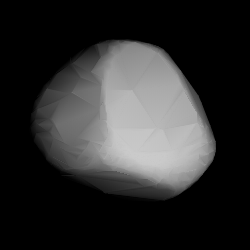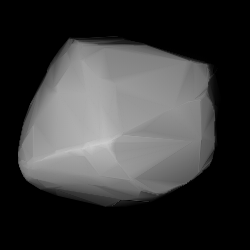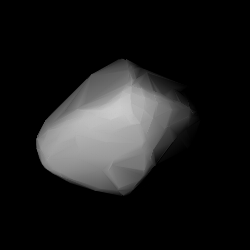Related Research Articles

1054 Forsytia is a dark background asteroid, approximately 46 kilometers in diameter, from the outer regions of the asteroid belt. It was discovered on 20 November 1925, by astronomer Karl Reinmuth at the Heidelberg-Königstuhl State Observatory in southwest Germany and assigned provisional designation 1925 WD. It is named after the flowering plant forsythia, and marks the beginning of a sequence of 28 thematically named asteroids by the discoverer.
1060 Magnolia, provisional designation 1925 PA, is a stony Florian asteroid from the inner regions of the asteroid belt, approximately 7 kilometers in diameter. It was discovered on 13 August 1925, by German astronomer Karl Reinmuth at the Heidelberg-Königstuhl State Observatory. The asteroid was named after the flowering plant magnolia.
1066 Lobelia, provisional designation 1926 RA, is a bright background asteroid from the inner regions of the asteroid belt, approximately 6 kilometers in diameter. It was discovered on 1 September 1926, by astronomer Karl Reinmuth at the Heidelberg-Königstuhl State Observatory in Germany. The asteroid was named after the flowering plant Lobelia (lobelias).
1070 Tunica, provisional designation 1926 RB, is a dark background asteroid from the outer regions of the asteroid belt, approximately 35 kilometers in diameter. It was discovered on 1 September 1926, by German astronomer Karl Reinmuth at the Heidelberg-Königstuhl State Observatory in southwest Germany. The asteroid was named after Petrorhagia, a flowering plant also known as "Tunica".
1072 Malva, provisional designation 1926 TA, is a dark background asteroid from the outer regions of the asteroid belt, approximately 48 kilometers in diameter. It was discovered on 4 October 1926, by astronomer Karl Reinmuth at the Heidelberg-Königstuhl State Observatory in Germany. The asteroid was named after the flowering plant Malva (mallow).

1077 Campanula, provisional designation 1926 TK, is a presumed Erigonian asteroid, approximately 9 kilometers in diameter, located in the inner region of the asteroid belt. It was discovered on 6 October 1926, by German astronomer Karl Reinmuth at the Heidelberg Observatory in southwest Germany. The asteroid was named after the bellflower Campanula.
1078 Mentha, provisional designation 1926 XB, is a stony background asteroid from the inner regions of the asteroid belt, approximately 13 kilometers in diameter. It was discovered on 7 December 1926, by astronomer Karl Reinmuth at the Heidelberg-Königstuhl State Observatory in southwest Germany. Only in 1958, it was realized that this object was a rediscovery of an already numbered but lost asteroid.

1080 Orchis, provisional designation 1927 QB, is an dark background asteroid from the inner regions of the asteroid belt. It was discovered on 30 August 1927, by German astronomer Karl Reinmuth at the Heidelberg Observatory in southwest Germany. The carbonaceous F-type asteroid has a rotation period of 16.1 hours and measures approximately 22 kilometers in diameter. It was named after the flowering plant Orchis.

1081 Reseda is a dark background asteroid from the outer regions of the asteroid belt. It was discovered on 31 August 1927, by astronomer Karl Reinmuth at the Heidelberg-Königstuhl State Observatory in southwest Germany. The asteroid has a rotation period of 7.3 hours and measures approximately 37 kilometers in diameter. It was named after the herbaceous plant Reseda.
1091 Spiraea, provisional designation 1928 DT, is a carbonaceous Cybele asteroid from the outer regions of the asteroid belt, approximately 36 kilometers in diameter. It was discovered on 26 February 1928, by astronomer Karl Reinmuth at the Heidelberg-Königstuhl State Observatory in southwest Germany. The asteroid was named after Spiraea, a genus of plants.
1092 Lilium, provisional designation 1924 PN, is a dark, carbonaceous background asteroid from the outer regions of the asteroid belt, approximately 44 kilometers in diameter. It was discovered on 12 January 1924, by German astronomer Karl Reinmuth at the Heidelberg Observatory in southwest Germany. The asteroid was named after the flower Lilium.
1097 Vicia, provisional designation 1928 PC, is an asteroid from the central regions of the asteroid belt, approximately 23 kilometers in diameter. Discovered by Karl Reinmuth at the Heidelberg Observatory in 1928, the asteroid was later named after the flowering plant Vicia, commonly known as vetches.
1104 Syringa, provisional designation 1928 XA, is a dark background asteroid from the central regions of the asteroid belt, approximately 23 kilometers in diameter. It was discovered on 9 December 1928, by German astronomer Karl Reinmuth at the Heidelberg-Königstuhl State Observatory in southwest Germany. The asteroid was named after the flowering plant Syringa (lilac).
1106 Cydonia, provisional designation 1929 CW, is a Eunomian asteroid from the central regions of the asteroid belt, approximately 13 kilometers in diameter. It was discovered on 5 February 1929, by astronomer Karl Reinmuth at the Heidelberg-Königstuhl State Observatory in Germany. The asteroid was named for the fruit-bearing tree Cydonia (quince). The S-type asteroid has a relatively short rotation period of 2.7 hours.

1231 Auricula (prov. designation: 1931 TE2) is a carbonaceous background asteroid from the central regions of the asteroid belt, approximately 20 kilometers (12 miles) in diameter. It was discovered on 10 October 1931, by German astronomer Karl Reinmuth at the Heidelberg Observatory. The likely elongated C-type asteroid has a rotation period of 3.98 hours. It was named after the flowering plant auricula and indirectly honors astronomer Gustav Stracke.
1250 Galanthus, provisional designation 1933 BD, is a dark background asteroid from the central regions of the asteroid belt, approximately 20 kilometers in diameter. It was discovered on 25 January 1933, by German astronomer Karl Reinmuth at the Heidelberg Observatory. The asteroid was named for the herbaceous plant Galanthus, also known as "snowdrop".
1227 Geranium, provisional designation 1931 TD, is a carbonaceous background asteroid from the outer regions of the asteroid belt, approximately 46 kilometers in diameter. It was discovered on 5 October 1931, by German astronomer Karl Reinmuth at the Heidelberg-Königstuhl State Observatory. The asteroid was named for the flowering plant Geranium (cranesbills).
1233 Kobresia, provisional designation 1931 TG2, is a carbonaceous background asteroid from the central regions of the asteroid belt, approximately 33 kilometers in diameter. It was discovered on 10 October 1931, by German astronomer Karl Reinmuth at the Heidelberg Observatory in southwest Germany. The asteroid was named for the grass-like flowering plant Kobresia, a genus in the sedge family.
1229 Tilia is a dark Themistian asteroid from the outermost regions of the asteroid belt, approximately 28 kilometers in diameter. It was discovered on 9 October 1931, by astronomer Karl Reinmuth at the Heidelberg Observatory in southwest Germany, and given the provisional designation 1931 TP1. The asteroid was named for the genus of trees, Tilia (lime tree, linden, basswood).

1422 Strömgrenia, provisional designation 1936 QF, is a stony Florian asteroid from the inner regions of the asteroid belt, approximately 5.5 kilometers in diameter. It was discovered on 23 August 1936, by German astronomer Karl Reinmuth at Heidelberg Observatory in southern Germany, and named after Swedish-Danish astronomer Svante Elis Strömgren.
References
- 1 2 3 4 5 "1232 Cortusa (1931 TF2)". Minor Planet Center. Retrieved 15 December 2018.
- ↑ Charles Harley Cleaveland (1871) Pronouncing Medical Lexicon, p. 71
- 1 2 3 Schmadel, Lutz D. (2007). "(1232) Cortusa". Dictionary of Minor Planet Names – (1232) Cortusa. Springer Berlin Heidelberg. p. 102. doi:10.1007/978-3-540-29925-7_1233. ISBN 978-3-540-00238-3.
- 1 2 3 4 "JPL Small-Body Database Browser: 1232 Cortusa (1931 TF2)" (2018-09-18 last obs.). Jet Propulsion Laboratory. Archived from the original on 18 September 2020. Retrieved 15 December 2018.
- 1 2 3 "Asteroid 1232 Cortusa". Small Bodies Data Ferret. Retrieved 15 December 2018.
- 1 2 "Asteroid (1232) Cortusa – Proper elements". AstDyS-2, Asteroids – Dynamic Site. Retrieved 14 December 2018.
- 1 2 3 4 Tedesco, E. F.; Noah, P. V.; Noah, M.; Price, S. D. (October 2004). "IRAS Minor Planet Survey V6.0". NASA Planetary Data System – IRAS-A-FPA-3-RDR-IMPS-V6.0: IRAS-A-FPA-3-RDR-IMPS-V6.0. Bibcode:2004PDSS...12.....T . Retrieved 15 December 2018.
- 1 2 3 4 Mainzer, A. K.; Bauer, J. M.; Cutri, R. M.; Grav, T.; Kramer, E. A.; Masiero, J. R.; et al. (June 2016). "NEOWISE Diameters and Albedos V1.0". NASA Planetary Data System: EAR-A-COMPIL-5-NEOWISEDIAM-V1.0. Bibcode:2016PDSS..247.....M . Retrieved 15 December 2018.
- 1 2 Masiero, Joseph R.; Grav, T.; Mainzer, A. K.; Nugent, C. R.; Bauer, J. M.; Stevenson, R.; et al. (August 2014). "Main-belt Asteroids with WISE/NEOWISE: Near-infrared Albedos". The Astrophysical Journal. 791 (2): 11. arXiv: 1406.6645 . Bibcode:2014ApJ...791..121M. doi:10.1088/0004-637X/791/2/121. S2CID 119293330.
- 1 2 3 4 Nugent, C. R.; Mainzer, A.; Bauer, J.; Cutri, R. M.; Kramer, E. A.; Grav, T.; et al. (September 2016). "NEOWISE Reactivation Mission Year Two: Asteroid Diameters and Albedos". The Astronomical Journal. 152 (3): 12. arXiv: 1606.08923 . Bibcode:2016AJ....152...63N. doi: 10.3847/0004-6256/152/3/63 . S2CID 119289027.
- 1 2 3 4 Nugent, C. R.; Mainzer, A.; Masiero, J.; Bauer, J.; Cutri, R. M.; Grav, T.; et al. (December 2015). "NEOWISE Reactivation Mission Year One: Preliminary Asteroid Diameters and Albedos". The Astrophysical Journal. 814 (2): 13. arXiv: 1509.02522 . Bibcode:2015ApJ...814..117N. doi:10.1088/0004-637X/814/2/117. S2CID 9341381.
- 1 2 3 4 Mainzer, A.; Grav, T.; Masiero, J.; Hand, E.; Bauer, J.; Tholen, D.; et al. (November 2011). "NEOWISE Studies of Spectrophotometrically Classified Asteroids: Preliminary Results". The Astrophysical Journal. 741 (2): 25. arXiv: 1109.6407 . Bibcode:2011ApJ...741...90M. doi:10.1088/0004-637X/741/2/90. S2CID 118700974. (catalog)
- 1 2 3 4 Usui, Fumihiko; Kuroda, Daisuke; Müller, Thomas G.; Hasegawa, Sunao; Ishiguro, Masateru; Ootsubo, Takafumi; et al. (October 2011). "Asteroid Catalog Using Akari: AKARI/IRC Mid-Infrared Asteroid Survey". Publications of the Astronomical Society of Japan. 63 (5): 1117–1138. Bibcode:2011PASJ...63.1117U. doi: 10.1093/pasj/63.5.1117 . (online, AcuA catalog p. 153)
- 1 2 3 Masiero, Joseph R.; Mainzer, A. K.; Grav, T.; Bauer, J. M.; Cutri, R. M.; Nugent, C.; et al. (November 2012). "Preliminary Analysis of WISE/NEOWISE 3-Band Cryogenic and Post-cryogenic Observations of Main Belt Asteroids". The Astrophysical Journal Letters. 759 (1): 5. arXiv: 1209.5794 . Bibcode:2012ApJ...759L...8M. doi:10.1088/2041-8205/759/1/L8. S2CID 46350317.
- 1 2 3 Behrend, Raoul. "Asteroids and comets rotation curves – (1232) Cortusa". Geneva Observatory. Retrieved 15 December 2018.
- 1 2 Carvano, J. M.; Hasselmann, P. H.; Lazzaro, D.; Mothé-Diniz, T. (February 2010). "SDSS-based taxonomic classification and orbital distribution of main belt asteroids". Astronomy and Astrophysics. 510: 12. Bibcode:2010A&A...510A..43C. doi: 10.1051/0004-6361/200913322 . Retrieved 30 October 2019. (PDS data set)
- 1 2 "LCDB Data for (1232) Cortusa". Asteroid Lightcurve Database (LCDB). Retrieved 15 December 2018.
- ↑ Schmadel, Lutz D. (2007). "(1234) Elyna". Dictionary of Minor Planet Names – (1234) Elyna. Springer Berlin Heidelberg. pp. 102–103. doi:10.1007/978-3-540-29925-7_1235. ISBN 978-3-540-00238-3.
- ↑ Schmadel, Lutz D. (2007). "(5699) Munch". Dictionary of Minor Planet Names – (5699) Munch. Springer Berlin Heidelberg. p. 483. doi:10.1007/978-3-540-29925-7_5391. ISBN 978-3-540-00238-3.
- ↑ Schmadel, Lutz D. (2007). "(1054) Forsytia". Dictionary of Minor Planet Names – (1054) Forsytia. Springer Berlin Heidelberg. p. 90. doi:10.1007/978-3-540-29925-7_1055. ISBN 978-3-540-00238-3.
- ↑ Garceran, Alfonso Carreno; Aznar, Amadeo; Mansego, Enrique Arce; Rodriguez, Pedro Brines; de Haro, Juan Lozano; Silva, Alvaro Fornas; et al. (January 2016). "Nineteen Asteroids Lightcurves at Asteroids Observers (OBAS) - MPPD: 2015 April - September". The Minor Planet Bulletin. 43 (1): 92–97. Bibcode:2016MPBu...43...92G. ISSN 1052-8091.